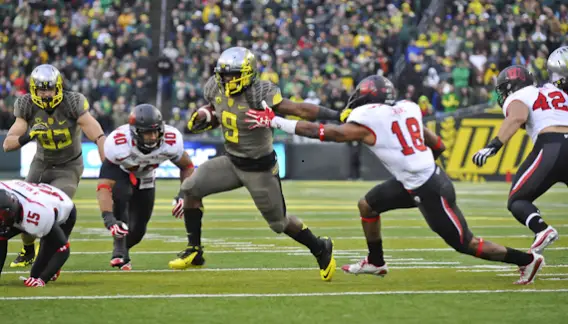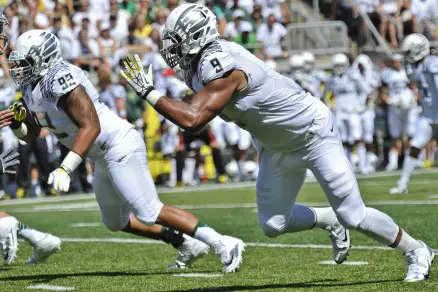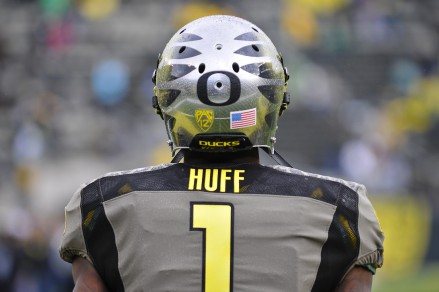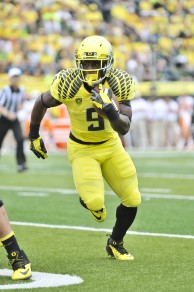Kevin Cline
Like they always do, the Ducks are closing strong as the 2014 recruiting cycle begins to wind down. The recent commitments of OT Braden Eggert, DB Glen Ihenacho and DE Henry Mondeaux give Oregon 14 commits to date. Given that the Ducks are expected to take between 18-20 players, only 4-6 spots remain.
Who will fill these remaining spots? Here’s my best guess:
1 ATH (Budda Baker)
1-2 OL (Quinn Bailey, Chris Brown)
0-1 DL (???)
1 LB (Jimmie Swain)
1 DB (Mattrell McGraw)
Bryce Dixon and JuJu Smith both had great visits, but the pull of the hometown schools, USC and UCLA, will probably be too strong for either to head north. Meanwhile, the Ducks are in great position to land Baker, Bailey, Swain and McGraw, at this point in time. It’s still possible that new targets could emerge, especially along the lines, where I wouldn’t be surprised to see a another JUCO commitment.
As I’ve discussed in the past, the staff isn’t overly eager to fill all of their available scholarships, and are more than willing to save those they can’t fill with ideal recruits. They’re already planning to save a few, which is why maximum capacity for this year’s class is 20 and not 24 or 25 like it technically could be. The prep class of 2015 is loaded out west, and the Ducks are already in the lead for a number of elite prospects from around the country. Thus, it wouldn’t be wise to fill scholarships with backup options. There’ll be plenty of those next year if the Ducks can’t land enough of their top targets in this recruiting cycle.
Don’t expect an elite recruit to come out of the woodwork and commit before national signing day; no JuJu Smith, Adoree Jackson or Miciah Quick. I had the feeling that if Oregon made another national championship run, an elite player or two might’ve made an emotional decision and hopped aboard the hype-train, but obviously, that’s not going to happen now. There’s still plenty of time for something unexpected to unfold, but it seems less likely now that the Ducks have faded from the national limelight.
Elsewhere around the conference, recruiting is down. There are several theories as to why this is, and each has an element of truth. For starters, USC’s early-season struggles and the Lane Kiffin drama hurt recruiting for a team that usually ranks near the top. Additionally, programs such as Stanford and UCLA, in addition to Oregon, haven’t had room to take the big size classes necessary to be highly ranked. Finally, it’s been a weaker year out west in general, relative to the national talent pool. All of that combined explains why no PAC-12 team is in the top-15 of the Rivals, Scout, 247 or ESPN rankings.
The only team having an above-average level of success is Arizona. Rich Rodriguez has done a great job of selling the program and bringing in talent. Currently, the Wildcats have the best class in the conference according to rankings, although that’s largely due to the fact that they have 27 commitments already. It’s also worth noting that Washington is having a horrible year, losing multiple commitments and placing last in PAC-12 rankings.
Expect Stanford, UCLA, USC and Oregon to finish the year strong, especially the Trojans. If AD Pat Haden makes the right choice for head coach, ‘SC could add a lot of talent in a hurry. Nonetheless, don’t expect the conference to come close to competing with the SEC, who currently boasts nine programs (NINE!) ranked higher than the best-positioned PAC-12 school.
I guess it pays to be located in the SE United States: only two programs located elsewhere, Ohio State and Notre Dame, are ranked in the Top-15. That’s incredible. Some of that may be due to evaluation bias, but that doesn’t hold much weight since rankings are similar across all four of the major services. The simple truth is that a large majority of the nation’s talent comes from that region of the country.
As Oregon fans, we should accept the geographical limitations that keep us from recruiting with the blue-bloods. The Oregon brand has certainly helped in that regard, but ultimately, location is an insurmountable obstacle. Most of the schools that recruit at a high level every year can throw a rock from their campus and hit a few elite recruits. That clearly isn’t the case in Eugene.
On the bright side, it will take a lot more than one bad loss to Arizona for Oregon to destroy the brand their program has built over the past five seasons. An elite brand built on the shoulders of mostly non-elite recruiting classes.
Related Articles:
Chip Kelly Update: Everything's Good Again ...
Chip Kelly Update: Wailing and Gnashing of Teeth
Shock and Awe -- The Oregon Ducks' Football Hangover Effect
Despite Lopsided Score, Georgia State "Never Stopped Believing"
Hope Springs Eternal for Ducks
Incompetent Pac-12 Officials: How Do You Miss ALL of THIS?
Chris was born in Montevideo, Uruguay, but made his way to Oregon by the age of five, when he attended his first game at Autzen Stadium. A huge sports fan at a young age, Chris grew up playing football, basketball and golf. Although realizing he isn’t likely to play in the NFL or NBA, Chris still holds on to hopes of being a professional golfer should his unfortunate putting woes take a turn for the better. A bit of a platypus, he attended both Oregon State and Oregon during his collegiate days where he earned a business degree in Finance and Business Administration. Chris works for Daimler Trucks North America in Portland, and plans to get his MBA from the University of Oregon.
Chris has been an active member in the recruiting community since 2005. He studies the intricacies of recruiting and is particularly intrigued by talent evaluation techniques. He is currently working on developing his own scouting reports for every scholarship player on the UO roster. Chris lives with his wife, Katrina, and his two-year-old son Lucas (a future dual-threat QB).




